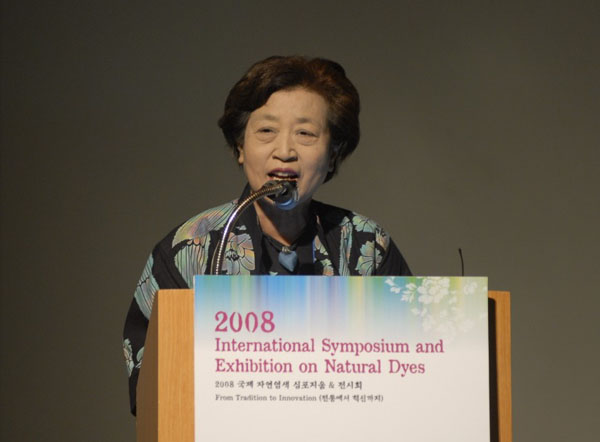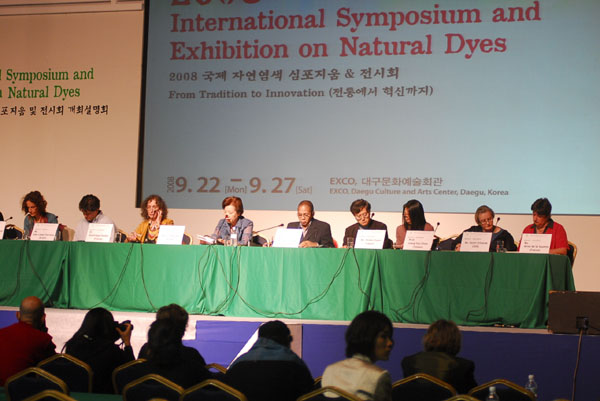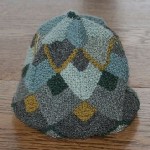How Natural is Natural? The Color Congress (Iowa) was held in 2002, and the Symposium on Natural Dyes (India) in 2006, where several hundred people from around the globe gathered. This time the location was Daegu, Korea, for the International Symposium and Exhibition on Natural Dyes (ISEND), 2008. With expressions of gratitude to the country of South Korea and the ever-hospitable Professor Kim Ji Hee, delegates were welcomed this past September. Professor Kim Ji Hee and Dr. Dominique Cardon presided over the events. In her keynote address, Prof. Kim Ji Hee spoke about the dynamics of classification of natural dyes, questioning whether every component of the dye, and of the dyeing process, necessarily needs to be natural in order for the final product to be termed "natural," both aesthetically and artistically. She also raised questions about how conditions for certification systems, both domestically and internationally will be used and monitored. Professor Kim provided an outline that was very comprehensive.
Dr. Cardon followed, commenting on the importance of these meetings, proposing an International Network concerning Natural Colorants, and recommending the establishment of an International System of Certification for Natural Colorants and Natural Dyeing.
The topic that figured prominently in conversation was how to unite and define natural dyes (colorants). How can authenticity and ecological responsibility be upheld or maintained? Another speaker addressed the challenge of creating a certification standard for natural dyes—the kind of monumental task that will need to be undertaken in many fields, as society wrestles with certification processes for a whole host of sustainable products.
Many other speakers shared information on natural dyes, ranging from findings about pigments in remote caves, to molecular structures that affect mordanting, to what those in industry are using to be successful with natural dyes. The workshops in the afternoons gave the participants opportunities to do what we all love—dye and talk about dyes. In the evening there were several events, including two very different, but wonderful fashion shows highlighting the use of the dyes.
As the conclusion of the conference, the delegates left with questions to bring back to their respective countries. I consider myself a second-generation modern dyer—I was not around when the first discoveries in dyeing and the cultures that surround this craft were happening. I missed the legwork that so many dedicated craftsmen, scientists and scholars were doing to continue the use of natural dyes. In the 15 years I have been dyeing, the West and the world have grown increasingly aware of phrases such as Green, Sustainability, Organic, Natural, Certified, Pure, Non-toxic and their meanings. What does it mean to be "green"? Who gets to decide when something is organic and how should it be labeled? For something to be natural must all of its components be natural as well?
Hopefully, when we meet again, we will be able to reach a set of conclusions about how we define and classify "natural dyes." If this can be accomplished, perhaps then we can develop a standardized certification process. I invite readers to think about these questions and respond. Having this dialog is one way we can promote and protect the use of natural dyes.
Notes from ISEND 2008, Daegu, South Korea
By Patricia Martin




 Turkey Red Journal
Turkey Red Journal

| Volume 14 Issue 2 | A Journal Dedicated to Natural Dyes | Spring 2009 |

Knit hat dyed with fresh leaf indigo.
Photograph Copyright by Ruth Cadoret
In this Issue
Articles:
• A Scottish Colour Kitchen
• Contact Dyeing
• Earth's Palette: Natural
Colors for Fiber
• International Shibori
Symposium 2008
• Returning To Art
• Book Review:
Judith H. Hofenk de
Graaff, The Colourful
Past: Origins, Chemistry
and Identification of
Natural Dyestuffs
Nature's Gallery:
• Diana Maher and
Patricia MacIndoe
Ribbon Cutting ceremony for the Arts and Culture Exhibition
Photograph courtesy Kim Ji Hee
Dr. Kim giving the opening keynote address
Photograph courtesy Kim Ji Hee
The last session table discussion about the organization
Photograph courtesy Kim Ji Hee
Participants in a dye workshop
Photograph courtesy Kim Ji Hee